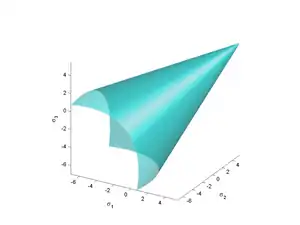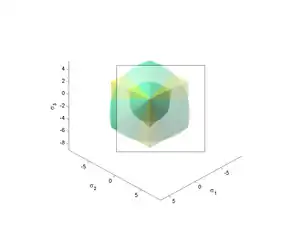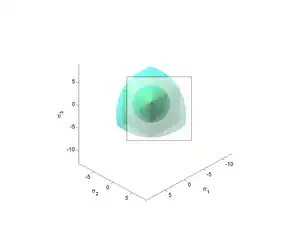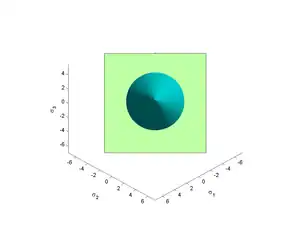Drucker–Prager yield criterion
The Drucker–Prager yield criterion[1] is a pressure-dependent model for determining whether a material has failed or undergone plastic yielding. The criterion was introduced to deal with the plastic deformation of soils. It and its many variants have been applied to rock, concrete, polymers, foams, and other pressure-dependent materials.

The Drucker–Prager yield criterion has the form
where is the first invariant of the Cauchy stress and is the second invariant of the deviatoric part of the Cauchy stress. The constants are determined from experiments.
In terms of the equivalent stress (or von Mises stress) and the hydrostatic (or mean) stress, the Drucker–Prager criterion can be expressed as
where is the equivalent stress, is the hydrostatic stress, and are material constants. The Drucker–Prager yield criterion expressed in Haigh–Westergaard coordinates is
The Drucker–Prager yield surface is a smooth version of the Mohr–Coulomb yield surface.
Expressions for A and B
The Drucker–Prager model can be written in terms of the principal stresses as
If is the yield stress in uniaxial tension, the Drucker–Prager criterion implies
If is the yield stress in uniaxial compression, the Drucker–Prager criterion implies
Solving these two equations gives
Uniaxial asymmetry ratio
Different uniaxial yield stresses in tension and in compression are predicted by the Drucker–Prager model. The uniaxial asymmetry ratio for the Drucker–Prager model is
Expressions in terms of cohesion and friction angle
Since the Drucker–Prager yield surface is a smooth version of the Mohr–Coulomb yield surface, it is often expressed in terms of the cohesion () and the angle of internal friction () that are used to describe the Mohr–Coulomb yield surface.[2] If we assume that the Drucker–Prager yield surface circumscribes the Mohr–Coulomb yield surface then the expressions for and are
If the Drucker–Prager yield surface middle circumscribes the Mohr–Coulomb yield surface then
If the Drucker–Prager yield surface inscribes the Mohr–Coulomb yield surface then
Derivation of expressions for in terms of The expression for the Mohr–Coulomb yield criterion in Haigh–Westergaard space is If we assume that the Drucker–Prager yield surface circumscribes the Mohr–Coulomb yield surface such that the two surfaces coincide at , then at those points the Mohr–Coulomb yield surface can be expressed as
or,
The Drucker–Prager yield criterion expressed in Haigh–Westergaard coordinates is
Comparing equations (1.1) and (1.2), we have
These are the expressions for in terms of .
On the other hand, if the Drucker–Prager surface inscribes the Mohr–Coulomb surface, then matching the two surfaces at gives
 Comparison of Drucker–Prager and Mohr–Coulomb (inscribed) yield surfaces in the -plane for
Comparison of Drucker–Prager and Mohr–Coulomb (inscribed) yield surfaces in the -plane for Comparison of Drucker–Prager and Mohr–Coulomb (circumscribed) yield surfaces in the -plane for
Comparison of Drucker–Prager and Mohr–Coulomb (circumscribed) yield surfaces in the -plane for
 Figure 2: Drucker–Prager yield surface in the -plane for |
 Figure 3: Trace of the Drucker–Prager and Mohr–Coulomb yield surfaces in the -plane for . Yellow = Mohr–Coulomb, Cyan = Drucker–Prager. | ||
Drucker–Prager model for polymers
The Drucker–Prager model has been used to model polymers such as polyoxymethylene and polypropylene.[3] For polyoxymethylene the yield stress is a linear function of the pressure. However, polypropylene shows a quadratic pressure-dependence of the yield stress.
Drucker–Prager model for foams
For foams, the GAZT model[4] uses
where is a critical stress for failure in tension or compression, is the density of the foam, and is the density of the base material.
Extensions of the isotropic Drucker–Prager model
The Drucker–Prager criterion can also be expressed in the alternative form
Deshpande–Fleck yield criterion or isotropic foam yield criterion
The Deshpande–Fleck yield criterion[5] for foams has the form given in above equation. The parameters for the Deshpande–Fleck criterion are
where is a parameter[6] that determines the shape of the yield surface, and is the yield stress in tension or compression.
Anisotropic Drucker–Prager yield criterion
An anisotropic form of the Drucker–Prager yield criterion is the Liu–Huang–Stout yield criterion.[7] This yield criterion is an extension of the generalized Hill yield criterion and has the form
The coefficients are
where
and are the uniaxial yield stresses in compression in the three principal directions of anisotropy, are the uniaxial yield stresses in tension, and are the yield stresses in pure shear. It has been assumed in the above that the quantities are positive and are negative.
The Drucker yield criterion
The Drucker–Prager criterion should not be confused with the earlier Drucker criterion [8] which is independent of the pressure (). The Drucker yield criterion has the form
where is the second invariant of the deviatoric stress, is the third invariant of the deviatoric stress, is a constant that lies between -27/8 and 9/4 (for the yield surface to be convex), is a constant that varies with the value of . For , where is the yield stress in uniaxial tension.
Anisotropic Drucker Criterion
An anisotropic version of the Drucker yield criterion is the Cazacu–Barlat (CZ) yield criterion [9] which has the form
where are generalized forms of the deviatoric stress and are defined as
Cazacu–Barlat yield criterion for plane stress
For thin sheet metals, the state of stress can be approximated as plane stress. In that case the Cazacu–Barlat yield criterion reduces to its two-dimensional version with
For thin sheets of metals and alloys, the parameters of the Cazacu–Barlat yield criterion are
| Material | |||||||||||
|---|---|---|---|---|---|---|---|---|---|---|---|
| 6016-T4 Aluminum Alloy | 0.815 | 0.815 | 0.334 | 0.42 | 0.04 | -1.205 | -0.958 | 0.306 | 0.153 | -0.02 | 1.4 |
| 2090-T3 Aluminum Alloy | 1.05 | 0.823 | 0.586 | 0.96 | 1.44 | 0.061 | -1.302 | -0.281 | -0.375 | 0.445 | 1.285 |
See also
| Part of a series on |
| Continuum mechanics |
|---|
References
- Drucker, D. C. and Prager, W. (1952). Soil mechanics and plastic analysis for limit design. Quarterly of Applied Mathematics, vol. 10, no. 2, pp. 157–165.
- McLean, M.R.; Addis, M.A. (1990). "Wellbore Stability: The Effect of Strength Criteria on Mud Weight Recommendations". All Days. doi:10.2118/20405-MS.
- Abrate, S. (2008). Criteria for yielding or failure of cellular materials. Journal of Sandwich Structures and Materials, vol. 10. pp. 5–51.
- Gibson, L.J., Ashby, M.F., Zhang, J. and Triantafilliou, T.C. (1989). Failure surfaces for cellular materials under multi-axial loads. I. Modeling. International Journal of Mechanical Sciences, vol. 31, no. 9, pp. 635–665.
- V. S. Deshpande, and Fleck, N. A. (2001). Multi-axial yield behaviour of polymer foams. Acta Materialia, vol. 49, no. 10, pp. 1859–1866.
- where is the quantity used by Deshpande–Fleck
- Liu, C., Huang, Y., and Stout, M. G. (1997). On the asymmetric yield surface of plastically orthotropic materials: A phenomenological study. Acta Materialia, vol. 45, no. 6, pp. 2397–2406
- Drucker, D. C. (1949) Relations of experiments to mathematical theories of plasticity, Journal of Applied Mechanics, vol. 16, pp. 349–357.
- Cazacu, O.; Barlat, F. (2001), "Generalization of Drucker's yield criterion to orthotropy", Mathematics & Mechanics of Solids, 6 (6): 613–630, doi:10.1177/108128650100600603, S2CID 121817612.